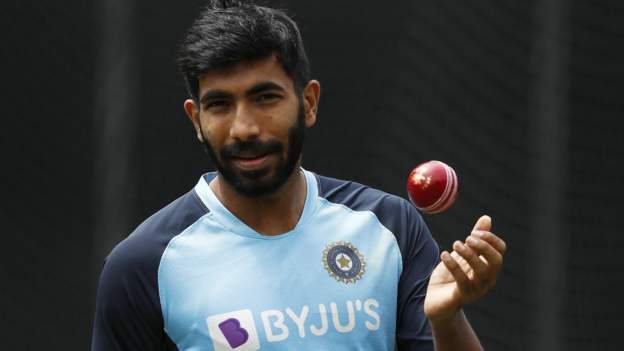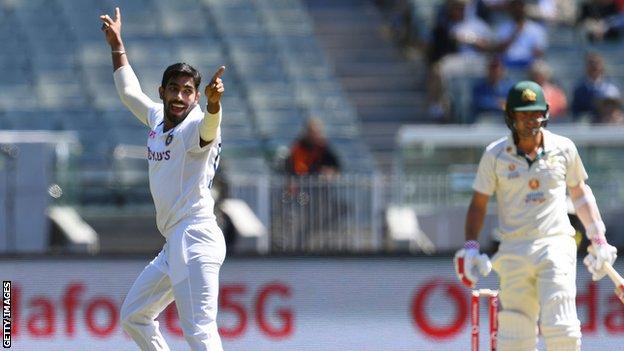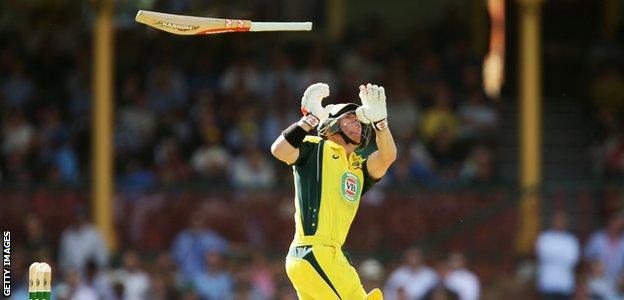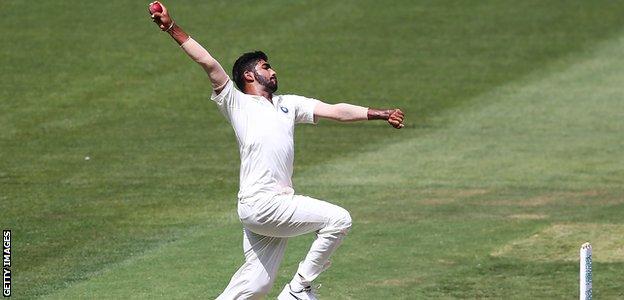
Bumrah - the story behind the bowling sensation

| Venue: Sydney Cricket Ground Date: 6 January |
| Coverage: Live radio commentary on BBC Radio 5 live sports extra & BBC Sport website, plus desktop, tablets, mobiles and app. |
Nobody can watch Jasprit Bumrah bowl for the first time without it grabbing their attention.
It starts off sweetly comical: India's premier fast bowler approaches the crease with a little horsey trot - back straight, knees bobbing.
His hands clasp, his elbows point outwards. Dressed in Test whites, you could imagine him at some country manor leaping over tiny hedges.
Right-arm bowlers are supposed to raise their left arm first, then swing it down for leverage. Instead, as he passes the umpire, Bumrah swings his bowling arm out in front of his body.
For a moment he holds the ball in an extended fist, like a kid playing Superman. Then the right arm keeps rising, above his head.
Finally the left follows. It reaches the horizontal and comes back down, as the right starts a circle around the clockface. At around nine, his elbow hyperextends like one of those plastic ball-throwers.
As the arm continues past midday towards the batsman, that flex snaps back into position. Then the magic trick: the ball vanishes.
At this point there is no longer anything cute about it. A strongly braced front leg lets the arm whip through. That casual beginning ends with a ball released at more than 90 miles per hour.
Sometimes it bends in at a right-hander and seams away. Sometimes reverse swing takes it in the other direction. Sometimes it's a perfect yorker.
In the shortest format, Bumrah hits his spot at will across four overs. In the longest, he can keep that simple action going all day.
"You don't face anything like that when you're growing up," says Australian all-rounder Ben Cutting, who played three seasons alongside Bumrah for Mumbai in the Indian Premier League.
"He's so explosive but he doesn't steam in. He sneaks up and you don't really hear him coming, and then he becomes a catapult that launches over the top.
"I faced him a fair bit at training, and when you're on a centre wicket at Wankhede, and it's dewy so the ball is flying, and the world's number one is coming at you - I took guard outside off stump a few times to get him to bowl the yorker instead of at my ribs."
These are some of the reasons Bumrah has become a star.
It doesn't hurt that he's the right level of handsome - relatably, not so much that you resent it. His beard goes just past designer stubble, his smile has dazzle, and his style of thick glasses and skinny jeans is a better look than the usual cricket fashion range that falls somewhere between casual real-estate agent and white rapper.
It doesn't hurt that he uses that smile a lot, loving life on the field. It doesn't hurt that he has a modest background, a street cricketer who broke into the IPL by volume of work and then became both India's most durable and most dangerous fast-bowling weapon.
"I can't explain why this action developed," he said while touring Australia in 2018. "As a kid I used to watch a lot of television, I used to copy everybody's action, so maybe it jumbled up. The run-up is small because I used to play a lot of tennis-ball cricket, so there the backyard was small, and that was the only place where I could do it."
The backyard was actually a stretch of concrete car park outside a massive apartment block in Ahmedabad, the main city in the state of Gujarat.
Not many Gujaratis end up playing for India, and Bumrah had a hard road there: he was five years old when his father died and his schoolteacher mother had to raise him and his sister with nothing to spare.
Bumrah became obsessed with cricket, and right from the start he had pace. He pushed through school teams and eventually to state level and to the IPL in 2013.
"I knew a fair bit about his story because he's one of the most down to earth, humble guys," says Cutting. "You can really talk anything with him, not just cricket.
"He's such a good yorker bowler because he used to bowl in the hallway when his mum was asleep, and he had to try to half-volley it into the skirting board so he didn't wake her."
| Tests | Wickets | Average | |
| Jasprit Bumrah (India) | 16 | 76 | 20.68 |
| Malcolm Marshall (West Indies) | 81 | 376 | 20.94 |
| Joel Garner (West Indies) | 58 | 259 | 20.97 |
| Curtly Ambrose (West Indies) | 98 | 405 | 20.99 |
| Pat Cummins (Australia) | 32 | 153 | 21.51 |
That life and those influences produced the player he is now. In the second Test against Australia, Bumrah dominated at the Melbourne Cricket Ground, taking four wickets in the first innings and six in the match to help seal a win and square the ongoing series.
Exactly two years earlier, he took six in the first innings and nine in the match, giving India a lead that became a series win. Two years before that, in 2016, he was in Australia for his international limited-overs debut.

On that first visit he was an afterthought, a development player picked in the fifth one-dayer after four defeats. But after three seasons in the IPL he was not in the least intimidated by the Sydney Cricket Ground.
While Australia racked up 330, Bumrah bowled his 10 overs for 40 runs. Steve Smith was at his peak, James Faulkner was the world's form late-overs hitter, and Bumrah got them both. He kept the score attainable and India chased it.
Three days later in Adelaide he played his first T20, dismissing David Warner alongside Faulkner again to finish with 3-23. India won that series 3-0, and losing has been the exception rather than the rule for him ever since.
Watching him that summer in Adelaide, Melbourne, Sydney, decoding his action, you couldn't help the thought he might be a passing curiosity, another IPL sensation.

The ever-searching scouts have turned up plenty: fast spinners and slow quicks, carrom-flickers and knuckle-ballers, whirlwinds or slingshots, tangle-footed or ambidextrous. For a time they confound with novelty but mostly they fade; mystery bowlers whose opponents soon skip to the last page.
Bumrah was the opposite. His unusualness was a footnote, not the text. Nor was he all about pace.
Over the years he has repeated his objective is consistency, and more than almost anyone he has delivered it.
Accuracy has set Bumrah apart, the basis for his seamless advance. He became the rare IPL graduate to move straight into international cricket with no stutter. Then straight through from short formats to Tests. He took each elevation in his stride.
He had a five-wicket haul in his third Test, rescuing a win in Johannesburg. Another bag of five in his fourth Test to beat England at Nottingham. Lead wicket-taker in the series win in Australia, then onto the West Indies. His spell of 5-7 in Antigua was named by Wisden as the best of 2019, a devastating display of seam and swing that took out stump after stump. In Jamaica he followed it with 6-27.
It hasn't been all smiles. Bumrah is fierce about his standard, and sometimes kicks at the turf or scolds himself when he doesn't meet it.
Leaving the field after a tough session in New Zealand at the start of 2020, he flinched away from team-mates who tried to pat him on the back, as if insisting he didn't deserve their encouragement or solace.
His childhood friends have recalled that temper. It never seems to be aimed at the opponent, though, and the smile returns before long.
"He's almost too friendly to be a fast bowler," says Cutting.
Except for the second when he bowls.
Most remarkable is what Bumrah done in such a short span. He's had eight years of IPL but a later start in Test cricket, having made his debut three years ago at the age of 24. So far he has played 16 Tests over five tours, and not one in India.
| Tests | Wickets | Average | |
| Jasprit Bumrah (India) | 6 | 29 | 18.82 |
| Chris Tremlett (England) | 4 | 21 | 24.61 |
| Dale Steyn (South Africa) | 7 | 31 | 28.77 |
| Mohammed Shami (India) | 8 | 31 | 32.16 |
| Morne Morkel | 6 | 23 | 34.04 |
All of which demonstrates just how good he is, because there is no doubt he is India's attack leader. That was even the case when he toured Australia last time, with all of six Tests to his name next to the veteran Ishant Sharma.
In the current series he's no longer just the leader, but the last man standing. Ishant never made it onto the plane, injured beforehand like Bhuvneshwar Kumar. Mohammed Shami had his arm broken in the first Test in Adelaide, Umesh Yadav hurt his leg in Melbourne.
The fast-bowling quintet that carried India to victory in 2018-19 has all but vanished in 2020-21.
And so this week Bumrah walks into the third Test at Sydney, back where he made his international debut five years ago. He has a series sitting at 1-1 with two matches to play, and a couple of very green bowling colleagues in his care.
It's all on him from here.
But that's alright: one thing that has never fazed Jasprit Bumrah has been stepping up.








